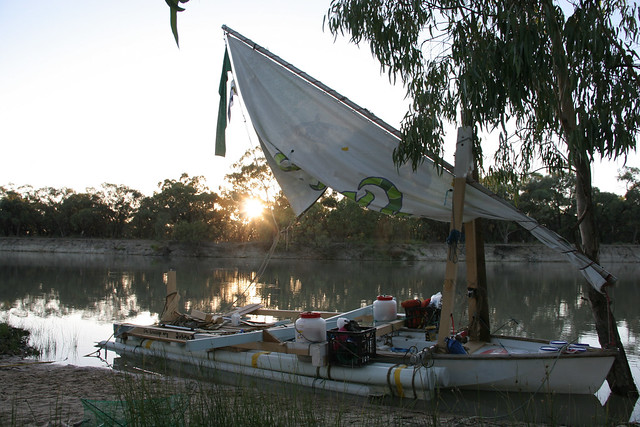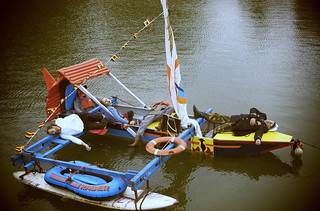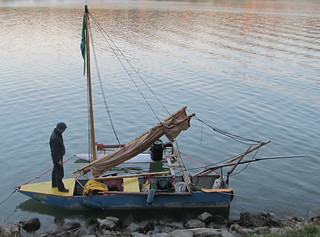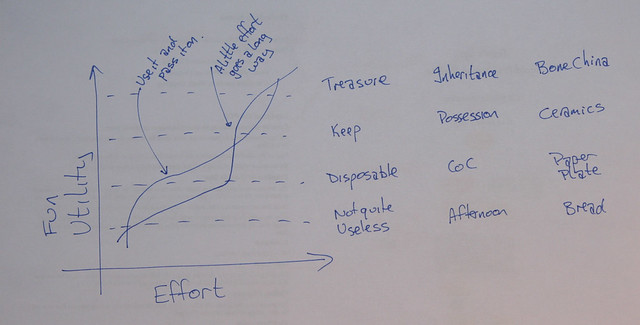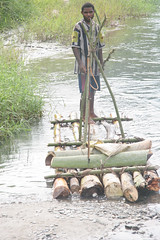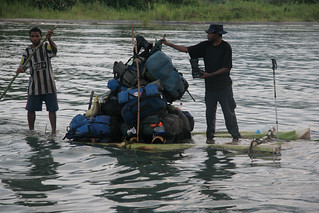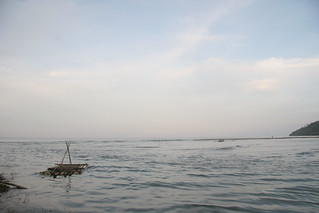Resilient Boating
by Tim Boykett
I was digging through old notes, a 25-centimetre high pile of them, to celebrate the last day of Discardia by, well, discarding. That's the idea of it. Get rid of the stuff in your life that is dragging you down by its mere existence. On a page of old note paper from around 2007 I found the following (translations added where needed):
- Reduce
- Reuse
- Recycle
- Für die Ewigkeit bauen (to build for eternity)
versus
- Alles nachher kompostieren (compost everything afterwards)
- If (good) things cost enough, then they will be made and cause e.g. the rainforests to be sensibly used
- Bootsbau (Boat building) as an example of Green Nomadism
- Joyon record trip → zero fossil fuels
- Gemütlichkeit (Comfort): no maintenance, wegwerfen (throw away)
- Mehr in schönheit und Pflege investieren, dann wird's länger benutzt (Invest more in beauty and care, then it will be used longer)
Benefits of Green Tech, making things possible
- long trips – sail beating
- extreme environment – mountain hut
- isolation from “the net”
- Tech nomadism
- weight falls away
- less complexity
Green Ocean Race – Eric Forsyth
These notes obviously left some ideas fermenting in my head. Let's see if I can pull some of them into a shape that is vaguely comprehensible to others.
Luminous Green Sailing
Francis Joyon is still the fastest solo world circumnavigator. His sailboat managed to be lighter and thus faster because, to a large degree, Joyon avoided using heavy generators and relied on renewable energy sources. By being greener, the boat was lighter, so it was faster. This was a story about green being luminous rather than green being a scratchy pullover and not enough heating. Too often “green” is interpreted and lived as a form of self-denial. Turning the heating down, wearing a scarf at the dinner table. Perhaps another solution is to re-design the heating as a pizza oven and invite friends over more in the winter to share food, wine and pleasure in a room warm and rosy with the open fire. For solo circumnavigation sailors, the practicalities of such efforts to be “green” are not purely about the vessel and the sailor, but also about sponsorship and media presence, safety and extreme speed. Whereas Moitessier was out of radio contact for months – his only communication home being through messages and film fired onto the decks of passing cargo ships with a slingshot – current solo circumnavigators appear online, give interviews and publicize their efforts continuously. This is a good thing when we recall the disappearance of Donald Crowhurst and the ensuing madness. These more recent circumnavigators therefore require significant electricity resources. Previously these resources were provided by generators and battery packs – a massive weight and complication. With green technologies, the needed electricity can be produced more with wind and solar energy, removing significant weight from the vessel.
Sailing could be the travel and transport of the future. Low emissions based upon the use of natural forces gives us a stupidly low ecological footprint for miles travelled – essentially zero. The permanent travellers Claudia and Juergen Kirchberger were on the road in the US when they noticed sailboats travelling past their campsites on the beaches and coastal headlands. They looked at the expense they had getting from one site to the next and noticed that these seagoing vessels were not paying anything except maintenance costs on their sails to go the same distances. And they were probably doing the repairs themselves. They ended up trading in their van for a sailboat in San Diego and spent three years on the Mexican coast and the Caribbean before abandoning it in a storm.
This might be the end of the story – just another forgotten wreck – and they thought that too until an email arrived from a friend in Austria. Their friend had been contacted by some fishermen who had salvaged the vessel, then floating around the Atlantic coast, and towed it back to harbour. There can be a lot of resilience built into a small vessel, even against the most extreme circumstances. Perhaps Shumacher's call to think small applies to living and travelling too.
Subak2_moored
Big enough, but no bigger
One term that has been floating around in recent economic and financial discussions has been that of an organisation that is “too big to fail.” On the water, this cannot hold, as we have seen with oil rigs and carriers breaking up. In a storm, many boaters head out into the open ocean, for out there there is nothing that can really go wrong. And there a small vessel can often survive more than a larger one, as the larger vessel can be caught between two massive waves, “breaking its back” as it is lifted from the water and sinking immediately.
Schumacher's core idea is not of smallness, but rather that more is not better - that there is an optimal scale for things. This is also known as subsidiatry, a concept that arose from Catholic Social thinking with Pius': “It is an injustice and at the same time a grave evil and disturbance of right order to assign to a greater and higher association what lesser and subordinate organisations can do.” This reminds me somewhat of Occam's razor, applied to society rather than science or explanations in general. A resilient structure is big enough, but no bigger.
Another of Schumacher's principles is the shift from capital-intensive to labour-based methods. Perhaps this is related to the joy of doing rather than the efficiency of having something done. Here we can apply this principle in the use of muscle-trimmed sails rather than a capital-intensive motor. There are many reasons to minimise the use of a motor in a travelling vessel. It is estimated that every hour of motor usage will eventually equal one hour of maintenance – that's one reason. Fuel tanks and battery packs also have a finite capacity. Furthermore, by using our bodies we are actually engaging in the moment of sailing, acutely conscious and responsive to the environment around us – not hidden away in a cabin with no more awareness of the outside world than the chugging of a diesel engine below.
Trying to translate some of Schumacher's ideas into sailing life is the goal of many among the growing community of long-term cruisers. The £200 Millionaire is an old story written by William Martyr in 1932 exploring these ideas, which have been taken up more recently in such books as Annie Hill's Voyaging on a Small Income. Hill explains how a thoroughly sustainable lifestyle can be built up, with intelligence and planning, in the minimalism of living on a small, but not too small, sailing boat.
However it is not all roses. A cursory reading of a sailing magazine, particularly a German one, might undermine the idea that sailing can be a (financially as well as ecologically) low-impact pastime or life choice. From the costs of a vessel, The cost of harbouring and maintaining the vessel, keeping the underwater parts free of algae and other fouling with toxic chemicals, and working out what to do with human and other wastes while sailing – all these are high-impact in so many ways. And trying to be more green by using local timbers often leads to the use of a slather of epoxies and other chemicals to keep the vessel waterproof.
So we are left in a quandary – sailing seems to offer solutions to our travel and transport impasses, but it also has a bunch of problems associated with it. This short essay tries to ease open this Pandora's box and show that it is an interesting box with some interesting things in there which might still be worth a look.
More than an afternoon and less than a decade
The Anarchist Yacht Clubb, Blue Anarchy, in their film Hold Fast, talk about the invention of the fibreglass vessel as the democratisation of boating. Suddenly boats were produced cheaply en masse on a production line by non-experts. Without the danger of wood rotting they required less care and attention, so lower maintenance costs and easier storage and use were possible. For the AYC, this has the advantage that a plastic boat, unless it is smashed or burnt, never really stops being a boat. So there are cheaper ways into the wonderful world of boating.
This is the benefit of persistence. Things that last for ever. Things that are sustainable in that sense that they endure as objects. Of course parts rust and osmosis can affect the fibreglass skin, but these problems do not sink the vessel. This wins the war of convenience. Whether intrinsically or extrinsically sustainable, these things will be around for a long time. Archeologists will dig up plastic boats in a thousand years just as they are digging up well-crafted perfectly buried viking vessels today.
Another approach to sustainability is through beauty and historical relevance. Whether the relevance is communal or just for one person, people look after the things that they deem significant. Antiquity helps, as is seen in the refurbishments of century-old classic vessels. Beauty helps too, and family or other emotional connections. A well-constructed vessel made from quality woods with a high degree of craftsmanship, as well as a family or other history is something that people want to protect.
A plastic boat survives a long time because it is resistant to decay. A wooden boat survives a long time because it inspires care. I will attempt to explain this in a moment. Probably some comparison to aged people here: those who get old because they have scavenged, saved, extorted and otherwise accumulated enough money to pay for someone to look after them, and those who get old because they have engendered love and compassion in those around them who want them to keep being around.
But is this sustainable? If everything we build is meant to last for ever, then our world we be filled with things to be maintained, whether by the immutability of the Long Now Clock or the rituals of Stephenson's Millenarians in Anathem. Is there a way (we asked ourselves) to build something useful, for more than an afternoon but less than a decade, something that can work and then dissipate into its components, to be recycled and re-used, composting to new purposes.
This is the direction that we took with CoC. Find some parts, old broken things that are given away or sold cheap, borrow some things, recycle some things. Combine them in hopefully useful ways and with any luck, something useful will come out of it. After using the vessels, pass them on in different ways, to be used, misused, recycled or otherwise appropriated for new roles. Trying to build for infinity is hard work and leaves things lying around that will last until infinity. Bloody annoying. And where do you store them?
So we build temporary. And it leaks. There are lots of ropes the same colour because getting multicoloured rope was not in the budget, but using the rope at hand – which was all black – was possible. “Pull the black rope!” was the call to remind us that we were making this all up as we went along.
Cooking in the sun and soaking in the rain
After our travels were over, a farmer took Subak2 out to his place on the Murray to live on the river and a theatre group in Brussels took the Subak for their climate catastrophe piece La Wallifornie. After the vessels were gone, we tried to work out what it had been about. What had worked, what was waste. What made sense, what we could have done without. One of the problems was efficiency. Neither vessel was particularly hydrodynamic. The Subak2 was based upon a racing dinghy, but the pipe extensions proved to be significant brakes. If we had learnt more from the Taiwanese pipe boats from which we copied the design, we would have invested more energy in turning up the bow of the pipe sections to allow them to flow over the water rather that plough it aside. The Taiwanese also use flat packing strapping to tie the pipes in contrast to the roung profile manilla rope that we were using. We were able to continue refining parts of the Subak2 en route as we had brought several tools with us. The yuloh (an auxiliary propulsion device) was iteratively refined until it became useful and functional. We also learnt to use it as we battled our ignorance of how it should be made and how it should be used.
Neither of the CoC vessels was waterproof, there was a constant seepage from barely perceivable cracks in the floors, which would sometimes become noticeable if pressure was applied on certain parts. But after an hour or three, enough water got into the boat to soak through bags that were not waterproof. As we were sleeping in the Subak on the canals of Belgium, this became an issue. We had to take out the floorboards and bail out the boat at least twice a day. Under then sun we were cooked, when it rained, we were wet. This collection of creature habits, including staying dry and sheltering from exposure, was something that we had more or less explicitly avoided. This was built into the project from the beginning – rather than attempt something that would be a “keeper” we wanted to pass the vessels on. They were temporary, but not just for an afternoon. We had decided that we would not do much more work to make the boats perfectly waterproof. A roof, a sun shade – these were things for another class of vessel.
Bread or china: balancing effort and utility
Reviewing the effort involved, there seem to be two axes: one is the effort put into something, the work or investment. And the other is the resulting utility, enjoyment, and other values that emerge from the effort invested. The term from economics that is perhaps relevant here is marginal costs, the extra amount of utility one gets from a small extra investment of effort. How much more effort does it take to get a small bit more utility? How much more utility do we get for a bit more investment? Measuring these small increments can be difficult, since they are always tied up with a background of previous efforts and their contexts.
The utility scale seems to have approximately four basic layers. Let's think about them in terms of dining. The easiest plate to use at a barbecue is a piece of bread. You would like some bread anyway, so use it as a plate to make an open sandwich, let it soak up meat juice, tomato sauce and some coleslaw and when the rest is gone you eat your plate. Not much good for more than a sausage – no cutting up cheese on that one. The next level of complication is paper plates, which can be thrown away when they have served their purpose. And the next stage might involve some mass produced ceramic item, while at the top of the scale we have the heirloom china.
Having dinner at home, the extra work involved in using the nicer ceramics as opposed to the plastic plates is negligible, so we use them, but the heirloom stuff stays packed away because there are clumsy kids about. Having a picnic we use the bread plates or the plastic ones depending upon how much work it is, whether we care about clean fingers (use a plate) or throwing away plastic (use bread). If we consider the wastefulness of single-use plastic plates, we might resort to compostable ones made from pressed palm leaves, or consider the extra work of transporting collecting, cleaning and storing enamelled plates worthwhile.
The four layers of utility seem to be: not quite useless, disposable, keep, and treasure.
The two curves on the diagram attempt to show the amount of work needed for something that is useful and disposable versus something that is worth keeping. This probably also has a lot to do with the amount of effort one has already invested, as the first hour of any project hurts a lot more than the hundredth. (A formal analysis here would be straying into the realms of economists and efficiency consultants – for our purposes we can leave them fairly rough-and-ready.)
From plastic rafts to wooden yachts and knowing when to stop
In connection to boating, we can think about these layers of utility as follows. The bottom layer is the one-use-only raft of plastic bottles roped to an inflatable mattress and some sticks, made for fun on a summer afternoon and taken apart when we leave. The disposable version might be the river rafts that I observed being used on the Fransisco River near Salamaua in Papua New Guinea. Cutting down some wild bamboo or other fast-growing trees, lashing them together with vines and using the construction to travel downstream before pushing the raft off to wash ashore elsewhere in the bay and biodegrade into compost.
The next level is the vessel we will keep for a few seasons or even decades, a racing dinghy or a fishing boat that slowly tears at the rivets and gets damaged in a series of small accidents until it becomes unusable. At the top of the scale we have the fine handworked craftperson's excellence in exquisite wood, a vessel that should be passed on through the generations.
The Subak and Subak2 of Control of the Commons were more than PNG river rafts, but not built to last for years. They were not envisaged as something that would fill up a supposed gap in our own or someone else's life, to greet us every Discardia by asking us why they were there. The amount of effort that would have been required to make them really work as functional long-term vessels was more than would have been useful. There is always one more thing to do. I think we are glad we didn't.
References, notes, and interesting tidbits
- Francis Joyon is a professional sail boat racer and yachtsman, and currently holds the record for the fastest single-handed sailing circumnavigation. https://en.wikipedia.org/wiki/Francis_Joyon
- The Long Now Clock is a huge clock, hundreds of feet high, ringing deep inside a mountain. It is designed to tick for 10,000 years. http://longnow.org/clock/
- Discardia is a holiday to celebrate and teach letting go of what doesn't add value to your life. http://discardia.com/
- “Encyclical of Pope Pius XI” given at St Peter's, Rome, the fifteenth day of May, in the year 1931, the tenth year of Our Pontificate: “79. As history abundantly proves, it is true that on account of changed conditions many things which were done by small associations in former times cannot be done now save by large associations. Still, that most weighty principle, which cannot be set aside or changed, remains fixed and unshaken in social philosophy: Just as it is gravely wrong to take from individuals what they can accomplish by their own initiative and industry and give it to the community, so also it is an injustice and at the same time a grave evil and disturbance of right order to assign to a greater and higher association what lesser and subordinate organizations can do. For every social activity ought of its very nature to furnish help to the members of the body social, and never destroy and absorb them.” http://www.vatican.va/holy_father/pius_xi/encyclicals/documents/hf_p-xi_enc_19310515_quadragesimo-anno_en.html
- Crowhurst and Moitessier: In the first ever solo nonstop world circumnavigation race in 1969 the two best-known stories are not about the winner, Knox-Johnston, but about the psychological developments of Moitessier and Crowhurst. Moitessier was winning when he abandoned the race at Cape Horn to carry on to Tahiti “for my soul.” Crowhurst stopped racing, faked a complete log book and re-entered the race as others began heading north up the Atlantic. His mental health broke down in the isolation and his boat was found drifting with no sign of him.
- Blue Anarchy “Hold Fast”: “One winter, three friends and I resolved to meet in south Florida, find a derelict sailboat, fix it up, and sail off into the Caribbean. Hold Fast is a 'video zine' about our trip: both the story of being broke while repairing a completely wrecked boat in Ft. Lauderdale, as well as the story of what we learned about sailing as we inched across the ocean towards Haiti.” http://www.blueanarchy.org/holdfast/
- Annie Hill. 2001. Voyaging on a Small Income. Brookline MA: Thomas Reed
- Claudia Kirchberger. 2012. Fortgeblasen und Angeschwemmt. Books on Demand
This is the description of a journey over three years, across the millennium, continued on the website at http://fortgeblasen.at. - Weston Martyr. 1956 [1932]. The £200 Millionaire. Hamilton & Co.
- Stephenson, Neal. 2008. Anathem. New York: William Morrow
- Ernst Schumacher. 1973. Small Is Beautiful: Economics as If People Mattered. New York: Harper & Row
An investigation of the way that economics could be adapted to better suit people. http://www.woodenwidget.com/milionaire.htm
